magine you're facing a tight deadline on a project. Suddenly, your computer freezes, and you lose hours of work. This scenario is frustrating enough on its own. Losing all that work also means losing time to get organized and improve your productivity workflow. Then, when you finally get your computer working again, you realize your work had no backup and wasn't even saved to a cloud-based system. If only you had a productivity tool to help you avoid all this chaos before it even happened. Well, that’s where artificial intelligence comes in. This article will highlight some of the best free AI tools to help you enhance productivity and workflow to avoid stressful situations like this one.
One way to achieve your objectives is using Antispace's AI-based productivity operating system. This tool can help you organize, establish workflows, and create a structure for your project. Then, when the deadline looms, you won’t have to panic. You can simply follow your workflows to complete your project on time and avoid the chaos of a last-minute computer crash.
How AI Tools Help Boost Productivity

There’s no denying it, AI is no longer just a buzzword. It’s a full-blown shift in how businesses operate. According to Gartner, AI is one of the most dominant tech trends 2024, and it’s not slowing down. If your company wants to stay competitive, embracing AI isn’t optional; it’s essential.
But let’s get specific. Over 73% of U.S. companies are already using AI in some capacity. That’s not just a stat; it reflects how quickly the workplace changes. Businesses aren’t adopting AI for the novelty. They’re doing it because it works.
Streamlining Repetitive Work
AI tools are incredibly good at handling repetitive tasks, the work that eats up your time, but doesn’t need human creativity. Think data entry, sorting emails, generating reports, or even managing calendars. Tools like Antispace, Notion AI, and Zapier integrations help automate these routines, giving your team more time to focus on what moves the needle.
Reducing Human Error
We all make mistakes, but AI makes far fewer. Whether proofreading a contract, calculating analytics, or managing workflows, AI systems can flag issues before they become costly problems. That’s a huge win for productivity and peace of mind.
Faster, Smarter Decision-Making
One of the most significant productivity boosts comes from faster access to insights. AI tools don’t just collect data, they help you interpret it. Whether it’s customer behaviour, project timelines, or budget forecasting, AI makes it easier to make informed decisions quickly.
Helping Employees Work Smarter, Not Harder
It’s not just about speed; AI also helps teams work more strategically. In a KPMG survey, 22% of businesses said they were already using AI to boost productivity. That includes AI-assisted brainstorming (with tools like ChatGPT), better time management, and even AI-generated project outlines.
Supporting Creativity and Innovation
Ironically, one of the most significant benefits of AI is freeing up space for human creativity. Employees not bogged down with admin tasks can focus on developing new ideas, exploring strategic opportunities, or building better products and experiences.
AI isn’t here to replace your team but to amplify them. Businesses getting ahead right now know how to pair innovative tools with smart people. If you’re looking for ways to improve productivity across your business, AI tools might be the competitive edge you didn’t know you needed.
Related Reading
- What Is Productivity Software?
- Pyramid of Productivity
- Small Business Intelligence
- Using AI to Enhance Business Operations
- Methods to Improve Productivity in Operations Management
- AI Workflows
31 Best Free AI Tools to Enhance Workflows and Boost Productivity
1. Antispace: The AI-Powered Productivity Operating System
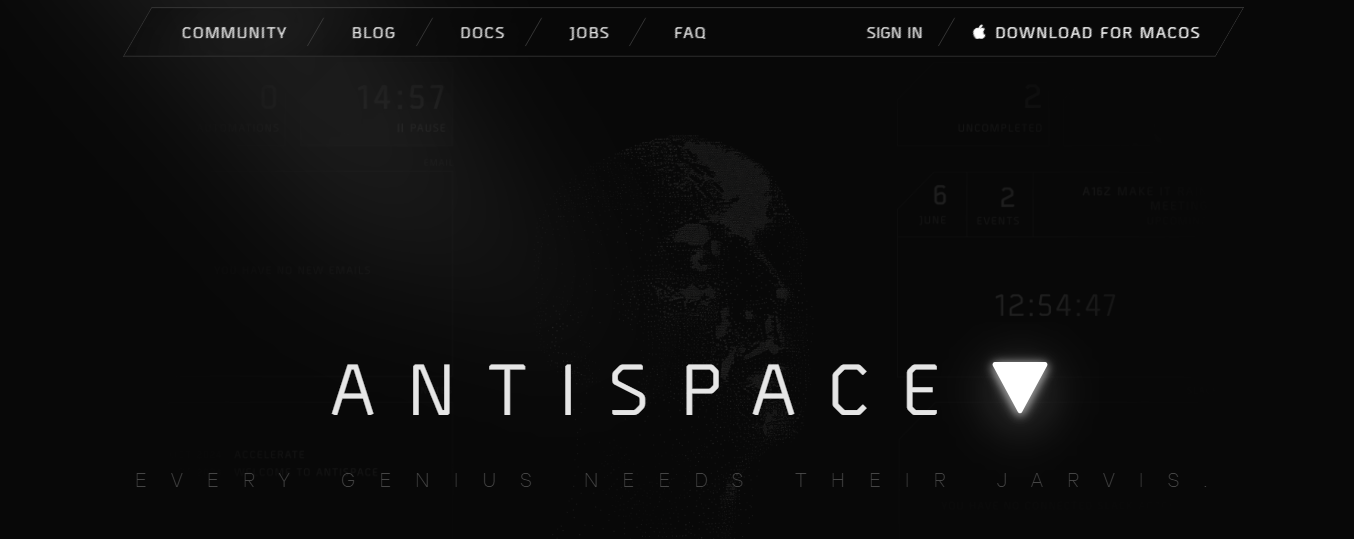
Antispace transforms your daily workflow with an AI-powered, gamified productivity operating system. Our platform seamlessly integrates with your essential tools, Email, Calendar, and Notes, while our AI assistant handles everything from email management to task organization.
We've built intelligence into every aspect of your workflow:
- Smart email responses
- Automated calendar management
- Enhanced note-taking
- Streamlined task coordination
Your AI Executive Assistant for Effortless Productivity
Antispace is your virtual executive assistant. It reduces context switching and automates routine tasks, letting you focus on what matters while our AI handles the rest. Whether you're brainstorming ideas, managing communications, or coordinating projects, Antispace turns productivity from a chore into an engaging experience.
Get started for free with one click today.
2. ChatGPT: Your AI Writing Assistant
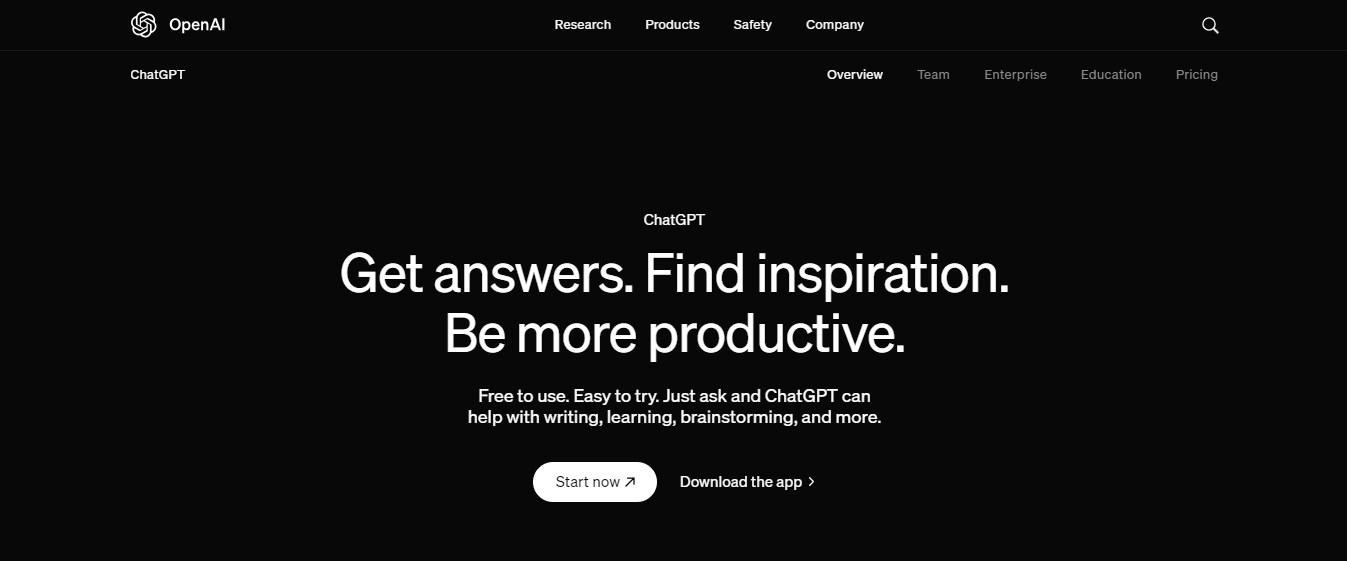
ChatGPT is an AI chatbot created by OpenAI. It is designed to engage in natural, human-like conversations and assist with various tasks by processing and generating language-based responses. It composes coherent and contextually relevant text, such as emails, essays, and code, making it a versatile tool for personal and professional use.
The platform is accessible to the public. It has a free version and a paid subscription model, ChatGPT Plus. The latter provides users premium features, including priority access to newer language models and improved response times.
Key features include:
Plugin functionality
Integrate specialized plugins that allow it to interact with external APIs and databases, expanding its knowledge base and enabling it to provide information not natively stored in its training data.
Code generation and interpretation
Write and debug simple code in various programming languages. This tool allows developers to brainstorm or troubleshoot coding issues.
Language support
Supports multiple languages, making it accessible to a global user base and allowing for cross-language conversations and content generation.
3. Claude: AI Model for Smarter Workflows
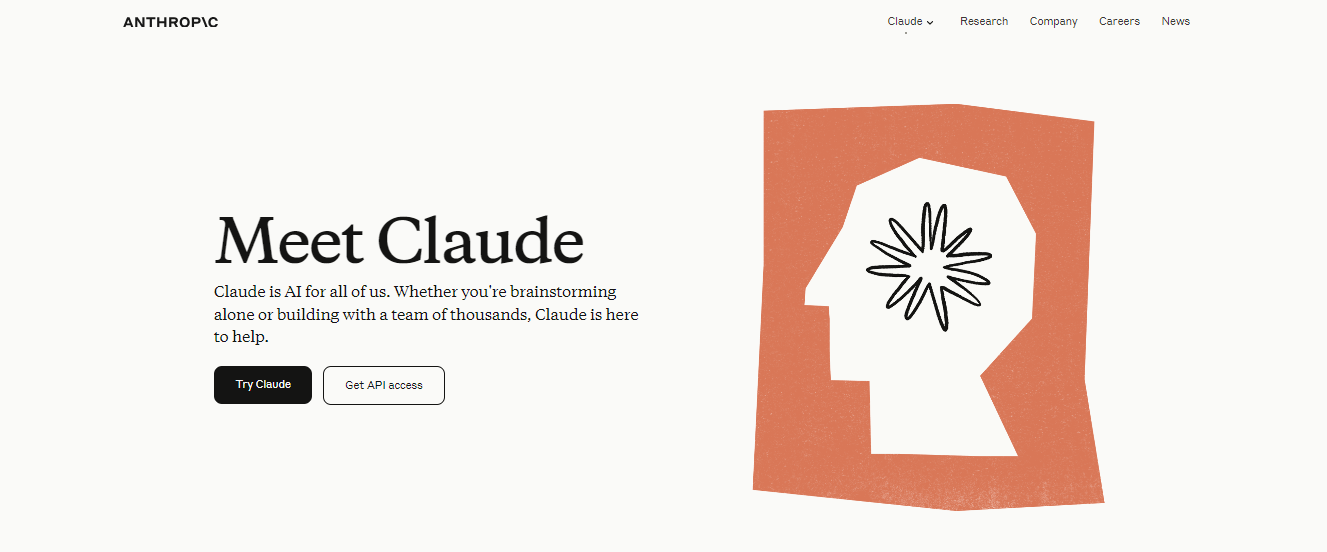
Claude is the latest iteration of a conversational AI developed by Anthropic. It is designed to improve interaction capabilities, enhance performance, and extend memory over its predecessors.
This AI model is available through an API and a public-facing beta website called claude.ai. It aims to be a friendly and helpful assistant for various tasks. With a focus on safety and user-friendliness, Claude 2 can be used for reasoning, language understanding, and content creation. Key features include:
Extended memory
The Claude 2.1 model can handle up to 200K tokens per prompt, enabling it to process and generate content over large documents or even entire books.
System prompts
Use a system prompt to direct Claude with specific tasks, roles, tone, context, creativity guidelines, external information, compliance rules, and output credibility checks.
Safety measures
Anthropic has implemented robust safety features and an internal red-teaming evaluation to ensure Claude 2 is less prone to generating harmful outputs.
4. Bard AI: The Google AI for Research
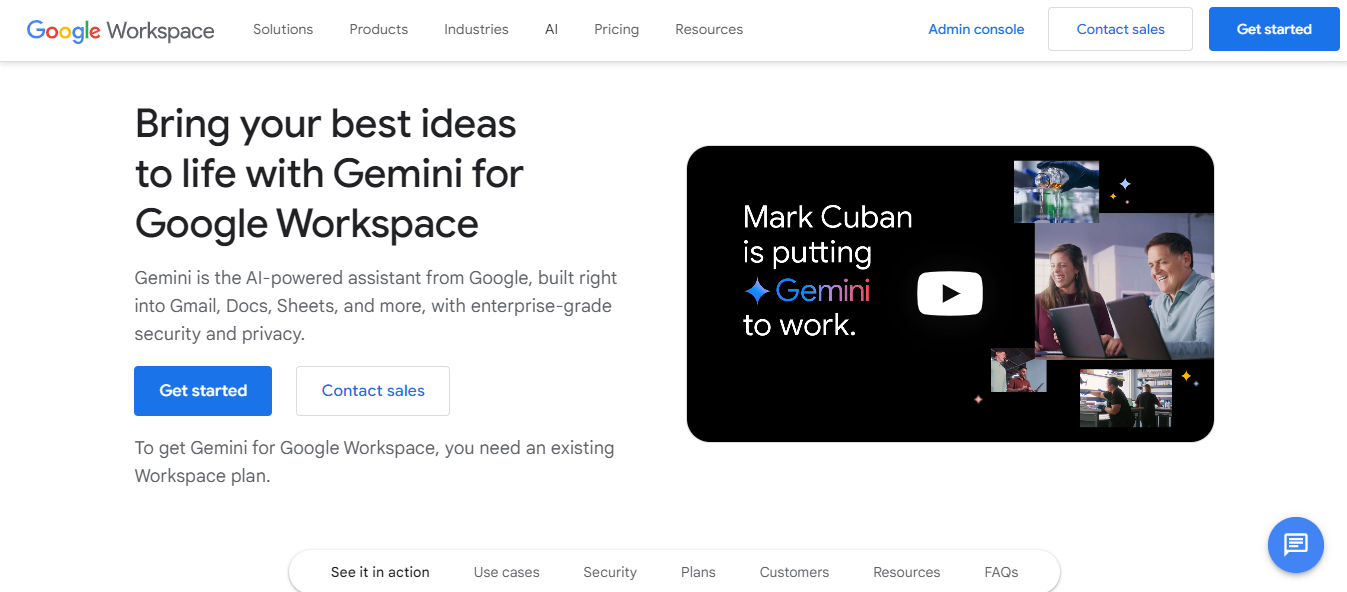
Bard is an experimental conversational AI service developed by Google, powered by its Language Model for Dialogue Applications (LaMDA). It’s designed to provide high-quality fresh responses by drawing information from the web.
Bard attributes direct, lengthy quotes to the source webpage and allows users to view and click through to the source via URLs or image thumbnails for verification and further exploration. Key features include:
Web-powered knowledge
Bard uses information from the web to offer up-to-date, relevant answers.
Fact checking
The system cross-references information from sources to check facts in search results and knowledge panels. It can flag questionable claims and upgrade credible information to curb misinformation.
Multilingual detection
Bard analyzes content in over 100 languages through machine translation and human review teams who are native speakers, expanding global coverage.
5. Descript: The AI-Powered Editing Tool
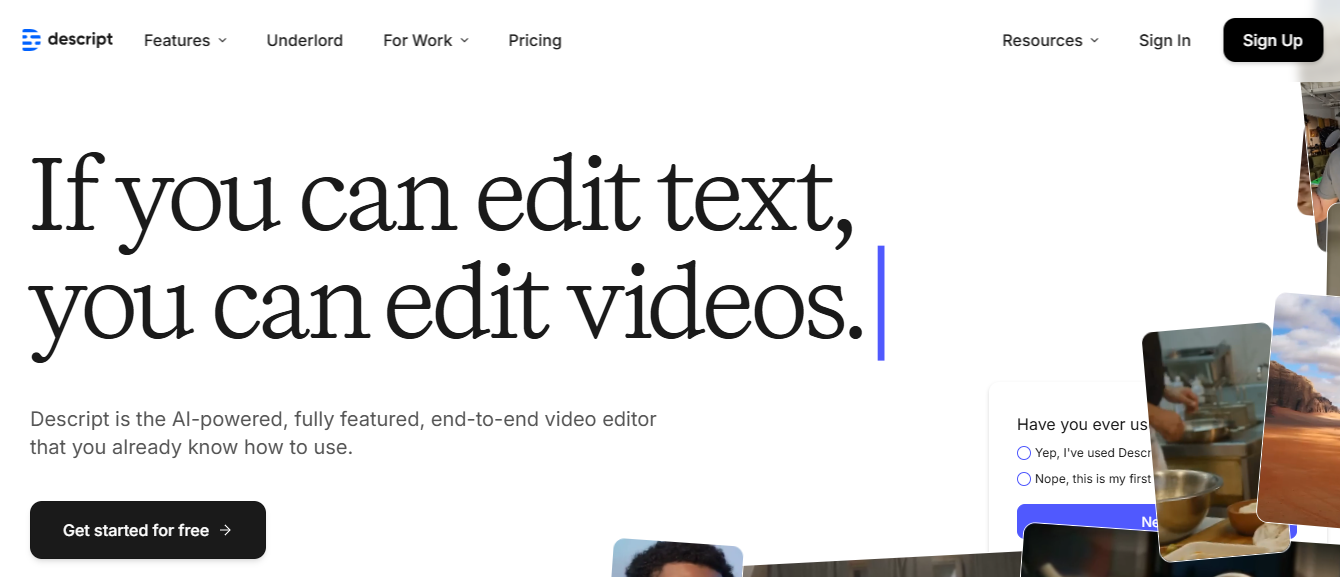
Descript is a powerful audio and video editing platform that integrates AI to streamline the content creation and editing process. It allows you to edit media files through transcribed text rather than fiddling with the audio file. The tool is easy to use and includes advanced features, making it a go-to solution for podcasters, journalists, and video producers. Key features include:
- Overdub and voice cloning: Mimic voices and insert new audio into recordings with typed text to correct errors or update content.
- AI green screen video editing: Remove and replace video backgrounds without needing a physical green screen, all with a simple one-click.
- AI-powered transcription: Convert spoken language into editable text quickly, enabling efficient content editing and repurposing.
6. Jasper: The AI Content Generator
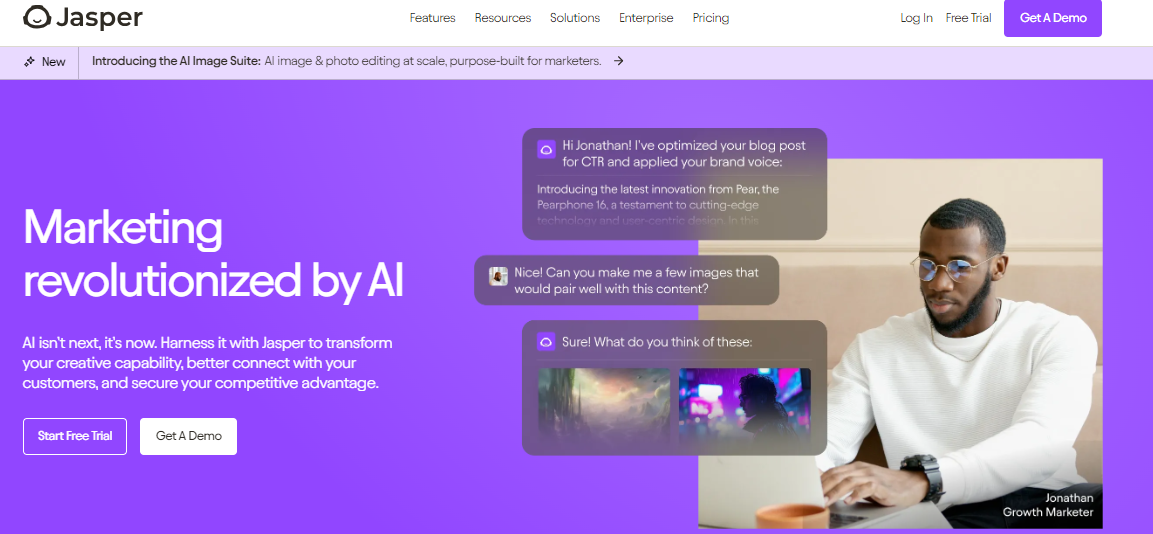
Jasper is an AI-powered writing assistant designed to help users generate high-quality content quickly and efficiently. The tool uses advanced language processing algorithms to create text for various purposes, from marketing copy to blog posts. It is tailored for content creators, marketers, and business owners who must produce large volumes of written content with less time investment. Key features include:
- Content generation: Generate original creative content based on user prompts and a set of parameters.
- Language model tuning: Tailor the AI’s writing style and tone to match specific brand guidelines or content goals.
- Multi-language support: Create content in multiple languages, catering to a global audience or localized markets.
7. Writesonic: AI for Marketing Copy

Writesonic is a set of AI-powered content generation tools designed to help marketers create high-quality copy for digital ads, blog posts, emails, and websites. It uses advanced language models to produce engaging content tailored to the specific needs of your audience. Their writing tool portfolio includes:
- Paraphrasing tool
- Text summarizer
- Story generator
- Text expander
- Landing page generator
Key features include:
- Diverse content templates: Choose from a wide range of pre-built templates for different types of content, from social media posts to full-length articles.
- Marketing copy generation: Create compelling ad copy, product descriptions, and other marketing materials designed to convert.
- SEO optimization: Built-in keyword optimization and the ability to add custom keywords ensure faster achievement of higher search rankings.
8. Hypotenuse AI: The AI Writing Assistant
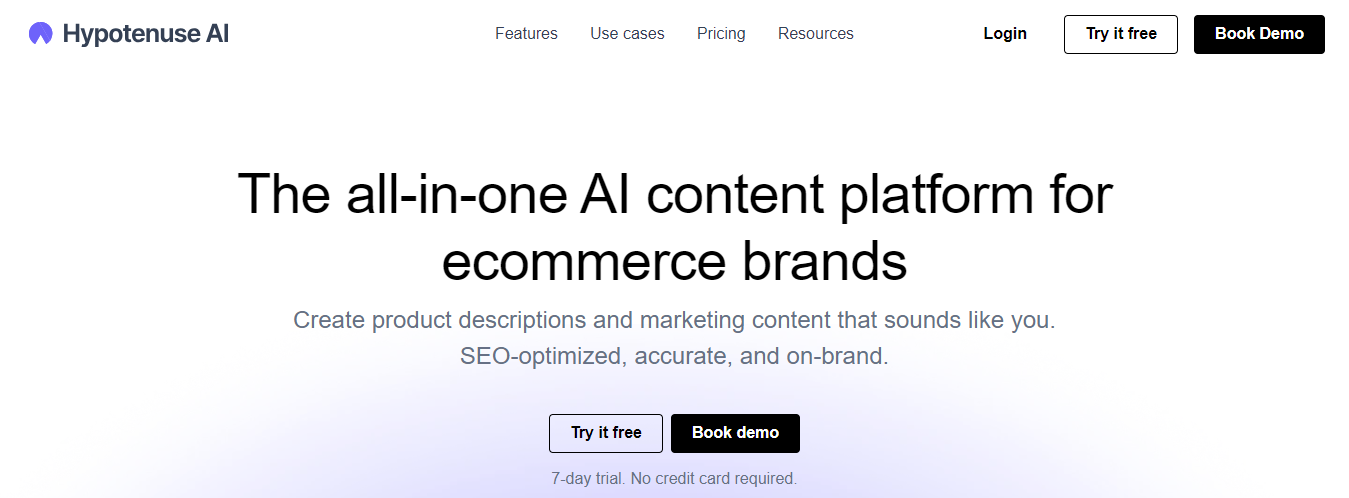
Hypotenuse AI is an AI-powered writing assistant and text generator designed to help create content that reflects a user’s unique brand and voice. It offers SEO-optimized, well-researched content across various types, from blog articles to social media posts.
With 20+ content types to choose from, including blog articles, product descriptions, and social media ads, the platform promises to save time and improve the quality of your content. Key features include:
- API integrations: Link your account directly to your Shopify storefront or WordPress website
- SEO and plagiarism tools: Ensure your content is optimized for search engines and is plagiarism-free
- Bulk content creation: Produce large volumes of content quickly and efficiently with the AI bulk generator feature.
9. QuillBot: The AI Paraphrasing Tool
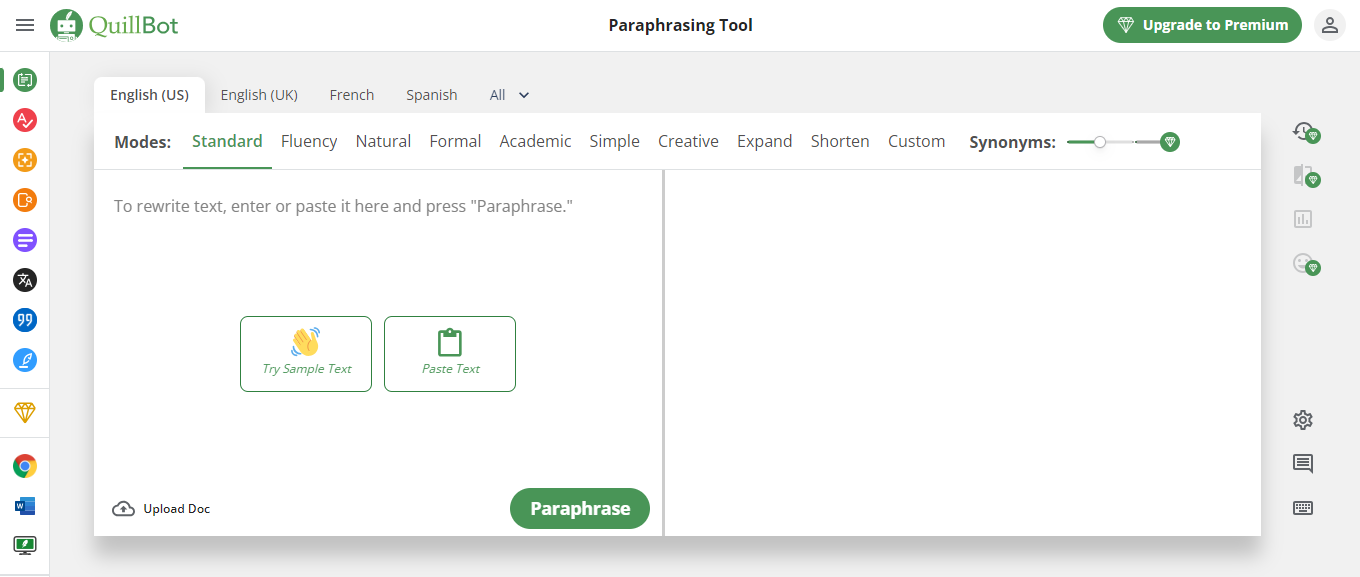
QuillBot is an AI-powered writing and research platform that offers tools to help users refine their writing and summarize articles and research topics.
Its primary function is as a paraphrasing tool, allowing writers to input text and rephrase it to improve clarity, prevent plagiarism, and vary language. QuillBot is widely used by students and academics, and it has tailored research features like its citation generator. Key features include:
- Paraphrasing tool: Use AI to rewrite existing sentences, paragraphs, or articles, maintaining the original meaning while altering the phrasing and structure.
- Grammar checker: Identify and correct grammatical errors to improve the overall quality of writing.
- Summarizer: Condense articles, documents, and lengthy pieces of text into shorter versions, capturing key points and main ideas.
10. Grammarly: The Writing Assistant

Grammarly is a digital writing assistant that uses AI algorithms to improve the quality of your writing by checking for various types of errors, from basic spelling mistakes to more complex grammar.
Grammarly is designed to improve clarity, coherence, and overall readability, whether for students or professionals, and is helpful for anyone who writes. The platform offers suggestions in real-time and can be integrated across different web apps and text editors, like Google Docs. Key features include:
- Real-time grammar checking: Detect and suggest corrections for grammar, punctuation, and spelling errors as you type.
- Style and tone adjustments: Provide writing style and tone recommendations to ensure the text matches the intended audience and purpose.
- Plagiarism detection: Scan texts against academic and web sources to ensure originality and prevent unintentional plagiarism.
11. Midjourney: Text-to-Image AI Generator

Midjourney is a text-to-image generation tool developed by an independent research institute. It is designed to transform written descriptions into high-quality visual content. The tool operates through a Discord bot, allowing users to input text prompts that the AI interprets to create images. It caters to non-commercial and commercial users, offering a range of subscription options. Key features include:
- Discord integration: Midjourney works with Discord, making it easily accessible for many users.
- Creative command customization: Users can tailor the AI’s output using simple prompts to adjust style composition and detail.
- Quick generation process: AI Midjourney can produce complex 3D visualizations in under 30 seconds.
12. DALL·E 3: Text to Image AI Generator

DALL·E 3 is an AI image generation model developed by OpenAI that creates original high-resolution images and art from text descriptions. This tool is handy for artists, designers, and content creators who need to visualize concepts or generate a variety of visual content without the constraints of traditional media. Key features include:
- Photorealistic outputs: The AI has enhanced its ability to produce photorealistic images, generating pictures that closely resemble real-life photographs.
- Outpainting capability: Expand an image beyond its original borders, creating larger scenes and landscapes that maintain the style of the initial picture.
- Variation and iteration: Generate multiple image variations from a single prompt to explore different creative directions.
13. Runway: An AI Software for Creators

Runway is an AI software platform that allows creators to use machine learning models easily and intuitively for various creative tasks, including video editing, image generation, and more. It is designed to make AI accessible to artists, designers, and video editors without requiring them to have a coding or machine learning background. Key features include:
- Generative models: Use cutting-edge AI models to generate images, videos, and animations from textual descriptions or modify existing content.
- Video editing: Offers AI-powered tools for tasks such as green-screen removal, style transfer, and depth estimation in videos.
- Plugin integrations: Integrate with other software suites, like Adobe Premiere Pro, for a seamless workflow that enhances traditional creative tools with AI capabilities.
14. Paperspace: Cloud Computing for AI

Paperspace by DigitalOcean is a cloud-based platform that provides access to powerful computing resources on demand. It enables developers, data scientists, and AI researchers to run complex machine learning models and high-intensity workloads.
It offers a suite of tools designed to streamline the development process, including GPUs for rent. Paperspace's user-friendly interface lowers the barrier to entry for anyone seeking the power of advanced computational hardware. Key features include:
- Low-cost GPUs: Save up to 70% on compute costs compared to the major public clouds or buying your own servers.
- Managed ML ops platform: Simplify machine learning workflows with tools for deploying, managing, and scaling AI projects.
- Collaborative development: Facilitate team collaboration with shared workspaces, notebooks and resources in a unified environment.
15. Zapier: The Workflow Automation Tool

Zapier is an online automation tool that connects your favorite apps, such as Gmail, Slack, Mailchimp, and more. It helps you automate repetitive tasks without coding or relying on developers to build the integration. It automatically moves information between your web apps so you can focus on your most important work.
The platform is handy for non-technical users and businesses looking to streamline workflows and enhance efficiency by creating automated sequences known as Zaps. Key features include:
- App integration: Connect and combine over 2,000 web apps to create custom workflows suited to individual business needs
- Interfaces: Craft web pages, forms, and simple applications to drive the essential processes of your business.
- No-code customization: Create and customize automations easily with a user-friendly interface that requires no programming skills.
16. Perplexity AI: The Question-Answering AI
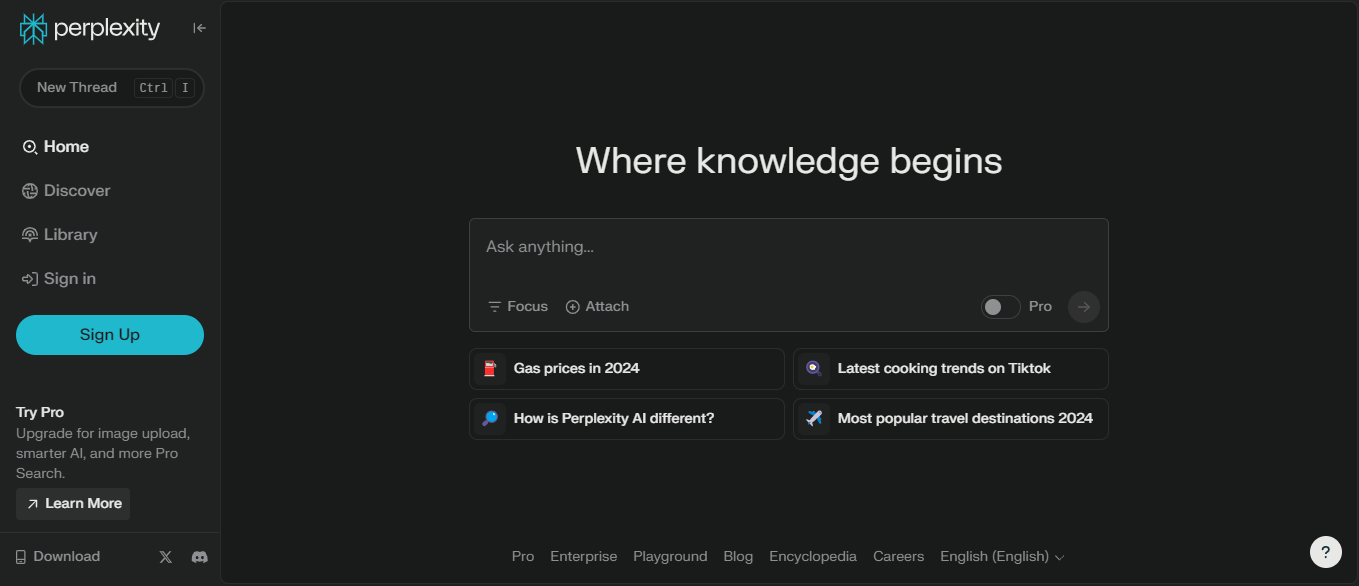
Perplexity AI is a conversational AI designed to answer questions, explain complex topics, and have detailed discussions with users. With its ability to understand context and generate human-like text responses, Perplexity AI provides users with an intuitive experience.
It’s particularly useful for educators, students, researchers, and anyone who needs quick, reliable explanations of intricate subjects. Key features include:
- Conversational understanding: Engage with users through natural context-aware dialogues, facilitating in-depth discussions and explanations.
- Knowledge-rich responses: Provide detailed answers and explanations from a broad knowledge base covering various topics.
- Interactive learning: Help users explore topics by asking clarifying questions and suggesting related areas of interest for further exploration.
17. GitHub Copilot: Your AI Pair Programmer
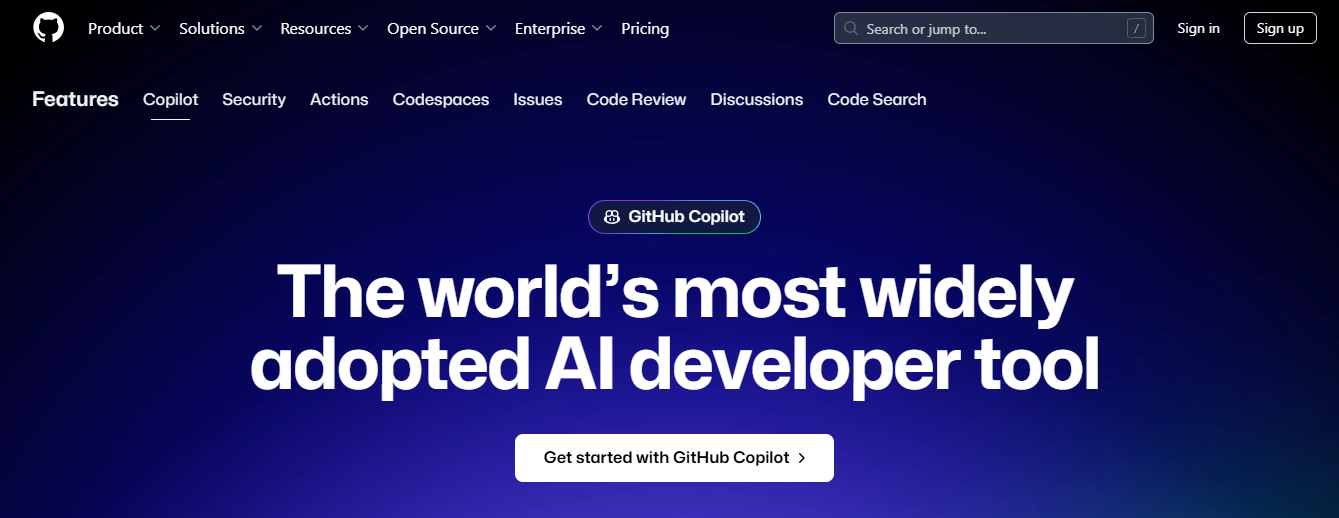
GitHub Copilot is an AI-powered code completion tool that helps programmers write code faster and with fewer errors. It suggests whole lines or blocks of code as developers type, learning from the context within the editor. Copilot is powered by a language model trained on a dataset of public source code, making it a powerful assistant for writing scripts, functions, and entire applications across different programming languages and frameworks. Key features include:
- Context-aware code suggestions: Offers code completions that adapt to the coding style and context of the project.
- Support for many languages and frameworks: It works with various programming languages and frameworks, providing relevant suggestions.
- Learning from the user: This method improves suggestions over time by analyzing the individual developer’s code patterns and preferences.
18. Notion AI: An AI Assistant for Notion
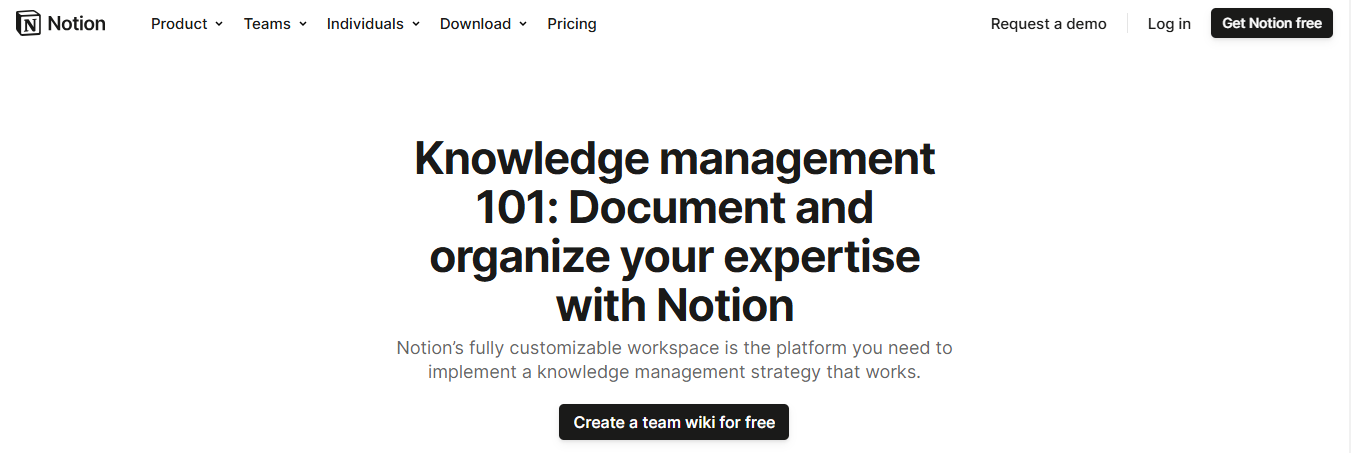
Notion AI is an artificial intelligence feature integrated into the Notion workspace. It improves the platform’s capabilities by assisting users in answering questions, generating content, and auto-filling tables within their Notion pages.
It uses AI to help users brainstorm, write, and edit documents and manage tasks and projects more efficiently. Notion AI is designed for individual users, teams, and organizations that use Notion as their all-in-one workspace. Key features include:
- Content creation and brainstorming: Use AI-powered writing and brainstorming tools to generate ideas, create drafts, and expand on thoughts.
- Summarization and organization: Summarize long pieces of text and organize information into structured outlines or notes for easier reading and reference.
- Task automation: Improve workflows by automating routine tasks and organizing content within your Notion pages.
19. Julius AI: The Data Analysis Assistant

Julius AI is an advanced data analysis platform designed to interpret and analyze structured data through natural language prompts, making it a virtual data analyst. It simplifies data visualization and complex analysis, such as regression modeling and projections, and it can create dynamic data animations. Key features include:
- Natural language analysis: Julius AI allows users to ask questions directly and receive analysis as if speaking with a human analyst.
- Data visualization generation: It can generate sophisticated data visualizations from simple instructions.
- Advanced analytical tools: The platform efficiently performs complex tasks like linear regression and data modeling.
20. Otter: AI Transcription Software
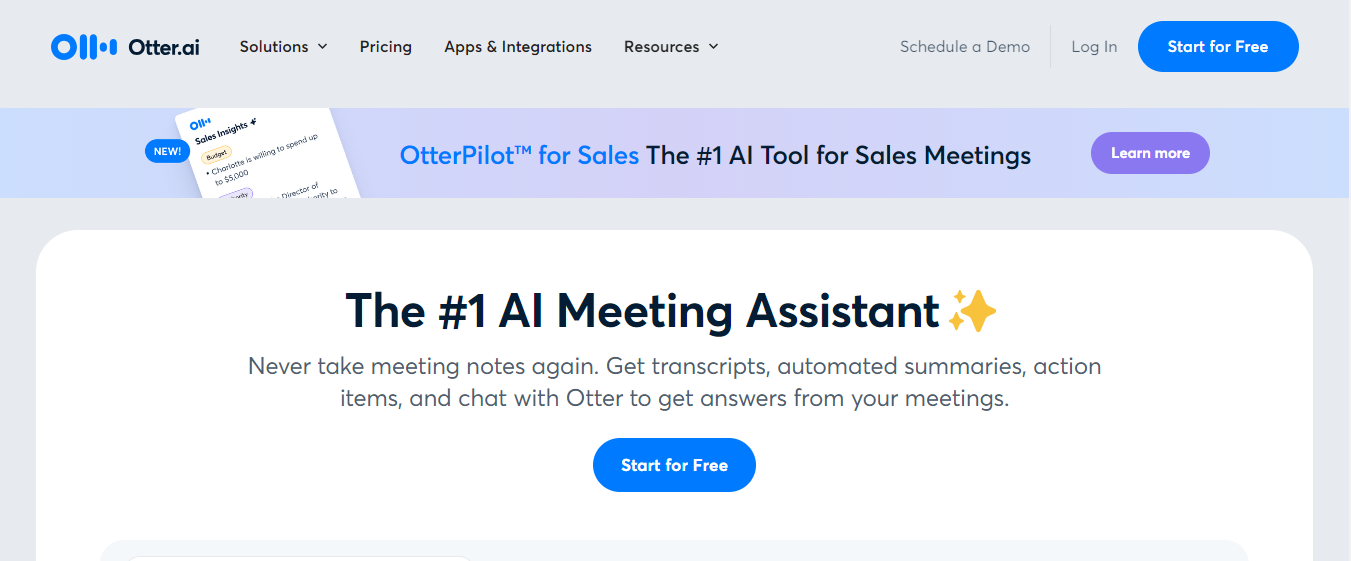
Otter is an AI-driven transcription service that converts spoken words into written text with high accuracy. It is beneficial for professionals who require transcription services, such as journalists, students, researchers, or businesses that need to document meetings and presentations.
Otter.ai is designed to capture and recognize speech from various sources and provide real-time transcriptions that users can edit annotate and share. Key features include:
- Real-time transcription: Transcribe speech as it happens, providing immediate access to written records of lectures, meetings, interviews, or any spoken content.
- Speaker identification: Differentiate between speakers in a conversation for meeting notes and interview transcripts.
- Audio and text synchronization: This feature allows users to playback the audio recording and see the corresponding text highlighted in sync, which helps review and edit transcripts.
21. Reclaim AI: The Smart Calendar
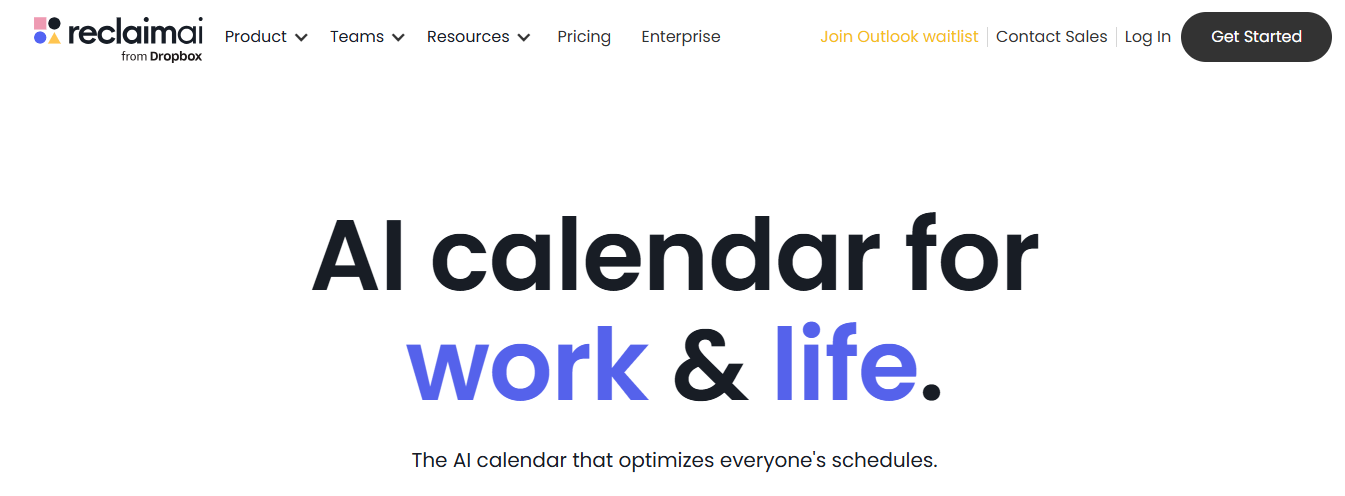
Reclaim AI is a scheduling app for team efficiency. It offers a smart calendar that optimizes time for improved productivity, collaboration, and work-life balance. The app aims to streamline scheduling by integrating various work tools and providing analytics for better time management.
Key features include:
- Automated task scheduling: Syncs with your task list for optimized daily planning.
- Focus time protection: Guard against meeting overruns and secure time for deep work.
- Time tracking report: Connect your calendar to see how you spent your time at work over the past 12 weeks.
22. Consensus: The Research Assistant

Consensus is an AI-powered search engine designed to analyze research papers and extract valuable insights. Its vast database includes over 200 million scientific documents, and it employs AI to provide instant summaries and relevant answers to research queries. Academics and professionals use the platform to cite peer-reviewed studies directly. Key features include:
- Extensive scientific coverage: Consensus allows for expansive searches across numerous scientific papers.
- Credible source-cited results: The search engine returns all results to their original studies without displaying ads.
- Instant data analysis: It leverages advanced AI to summarize and clarify research findings quickly.
23. Socratic: The AI Tutor
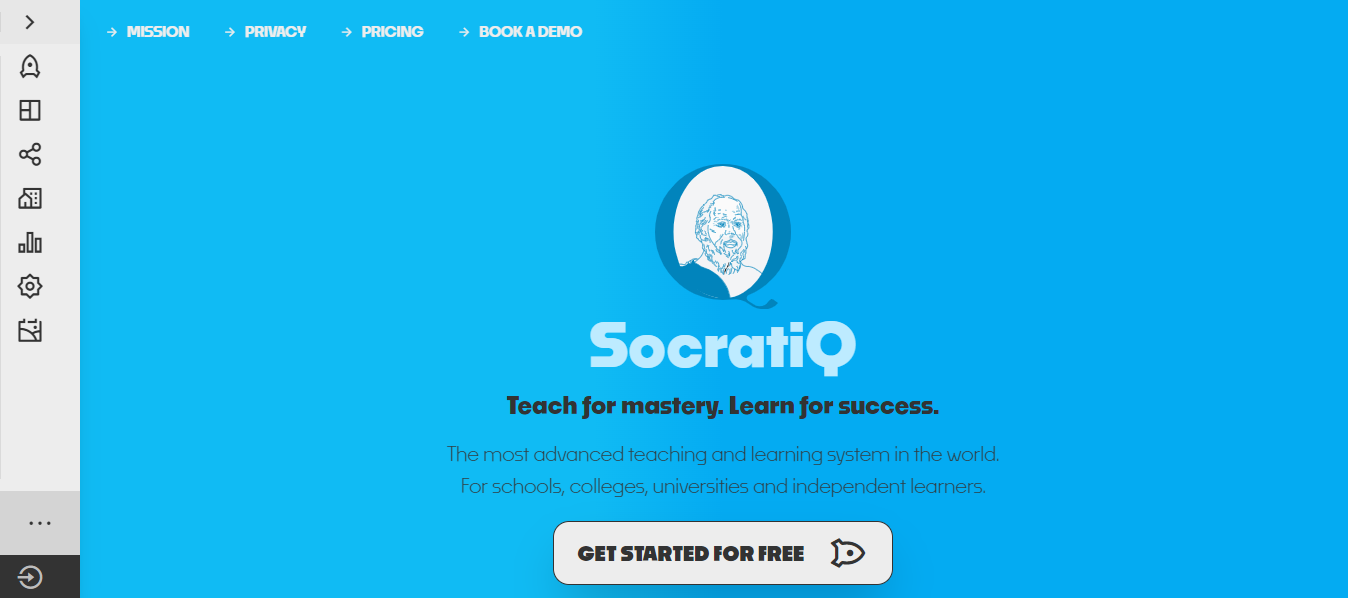
Socratic is an educational app that assists students in various subjects, including science, math, literature, and social studies. Using AI text and speech recognition technology,
Socratic visually explains complex concepts and guides learners to the most relevant resources. The app clarifies challenging topics and elevates students’ understanding. Key features include:
- Supports multiple platforms: Get support on a diverse range of academic disciplines on both iOS and Android.
- Voice support: As Socratic questions through the app’s audio-to-text feature.
- Google AI integration: Socratic uses advanced AI to deliver precise and relevant educational content.
24. Slides AI: AI for Presentations
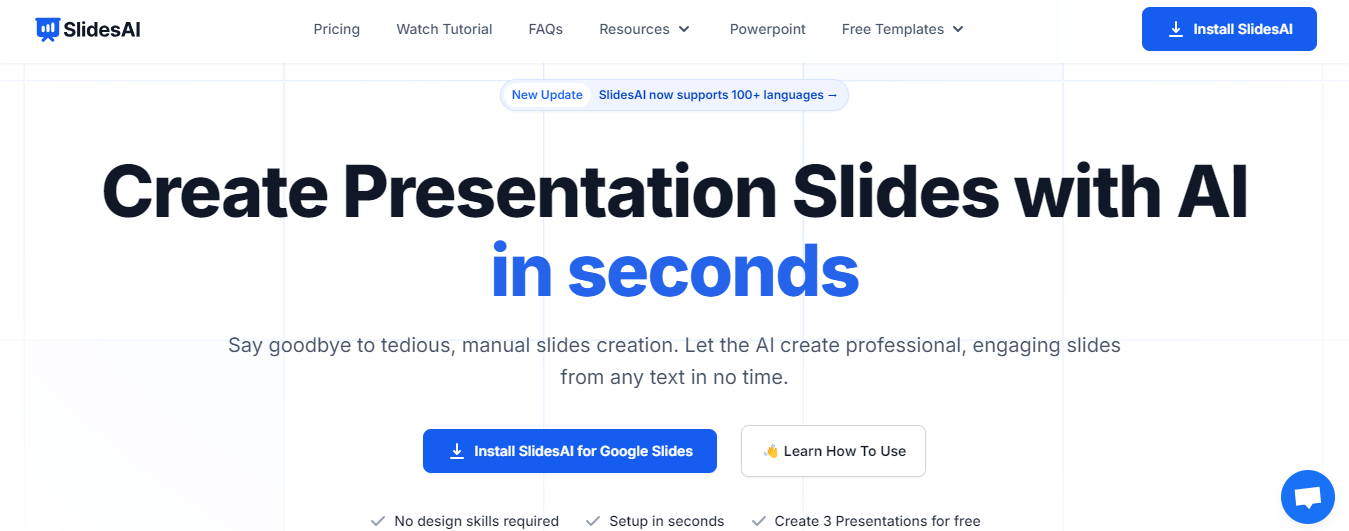
SlidesAI is an AI tool designed to automate the creation of professional presentation slides. It integrates with Google Slides, enabling users to transform text into a visually engaging presentation in seconds. With support for multiple languages and a user-friendly interface, SlidesAI simplifies the task of slide creation to convey your message more quickly. Key features include:
- Text-to-presentation automation: SlidesAI effortlessly converts input text into a complete presentation.
- Customizable design templates: Users can personalize presentations using pre-designed color and font presets.
- Multilingual support: The tool accommodates over 100 languages, boosting its global usability.
25. Synthesia: Text to Video AI Generator
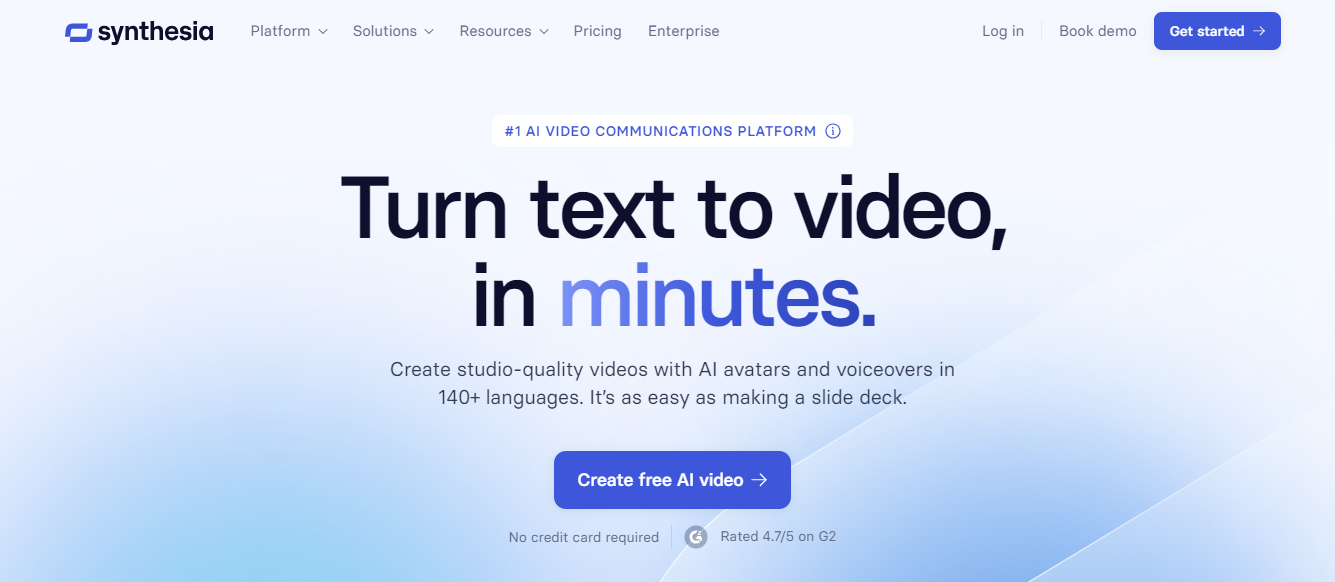
Synthesia is a video editing and creation platform that helps users transform text into video content. The platform offers over 140 AI avatars to help people take their ideas and create videos without hiring voice actors or buying production equipment. Synthesia can also turn text into speech in over 120 languages. Best for: Course creators, YouTubers, bloggers, and freelancers who want to streamline the video creation with a video generator.
Pros:
- API access to automate the creation process
- Templates for speeding up the video creation process
- Use brand materials for video creation.
26. Beautiful.ai: The AI Presentation Maker

Beautiful.ai assists professionals in creating slideshow presentations, offering hundreds of smart slides built with AI-assisted design. Users can add their content, and the smart slides will adapt based on that input. Beautiful.ai also allows users to convert their ideas into art, creating images to include in the presentation. Best for: Professionals wanting to create presentations.
Pros:
- Custom template library
- Viewer analytics for presentations
- Hundreds of pre-built slides
27. Optimal AI: The AI for Project Management

Optimal AI (previously Tara.ai) is a project management tool for engineering teams. The platform is a workspace that offers a unified view of engineering tasks, project documentation, and project progress. Optimal AI allows teams to work together, move projects through sprints, meet deadlines, and manage project issues. Best for: Engineering teams needing help managing projects.
Pros:
- Offers auto sprint management (creates sprints based on the team’s work and priorities)
- Tool integration will code repositories like:
- GitHu
- GitLab
- Measure return on investment (ROI) in real time
28. Copy.ai: The AI Copywriting Tool
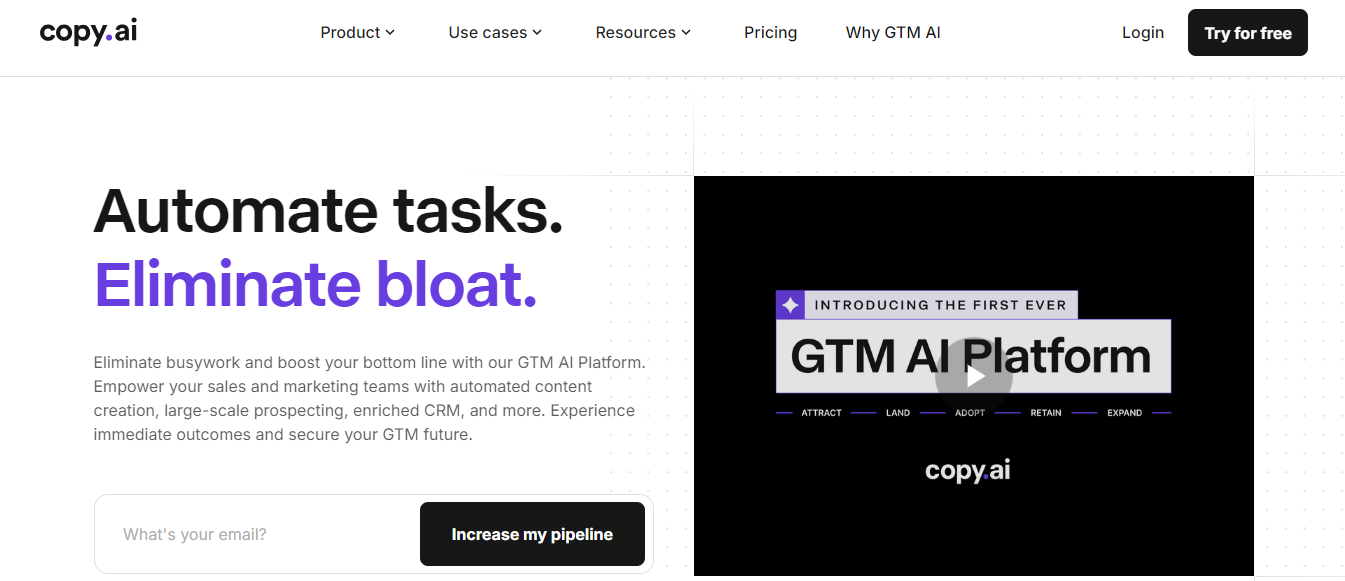
Copy.ai is an AI content generator that can create blog posts, ad copy for Instagram captions, and more. The platform offers more than 90 tools and templates. Users simply enter their copywriting project, give Copy.ai a bit of context, and choose between the platform’s options. Copy.ai’s editor can also rewrite paragraphs. Best for: Professionals wanting long- or short-form marketing content.
Pros:
- Supercharge mode allows users to input a URL for the AI to pull information from
- Unlimited characters for the Pro plan
- Create custom templates
29. Zoom IQ: AI for Sales Calls

Zoom IQ is an add-on to Zoom Meetings and Zoom Phone designed to enhance sales call productivity. The AI tool includes post-meeting analysis and analytics to help users analyze customer interactions, automate administrative tasks, and improve their sales process. Zoom IQ offers smart meeting recordings that generate chapter highlights and action items. Best for: Companies wanting to improve their sales performance with insights into sales conversations. Pros:
- Meeting analysis to show sentiment and engagement
- Offers sales funnel insights
- Track customer conversations and get customer event alerts
30. Wordtune: Another AI Writing Assistant
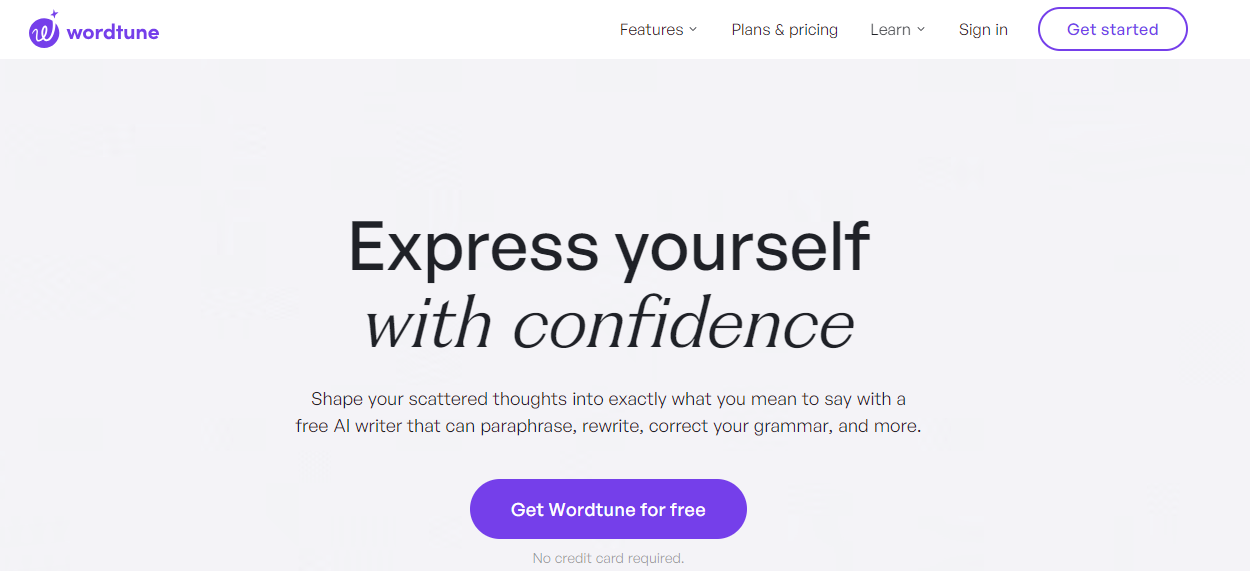
Wordtune is a writing assistant created by AI21 Labs that helps users rewrite sentences for better clarity and precision. The tool can rephrase sentences, suggest synonyms, and correct grammar and spelling errors. It’s available as a Chrome extension, web app, and mobile app. Best for: Professionals, students, and individuals who want to expand their writing and learn new ways to express ideas.
Pros:
- Can make writing more concise, clear, and engaging
- Comes with a browser extension
- User-friendly (simply paste text into the Wordtune editor)
31. Genei: AI for Research

Genei is an AI research and summarization tool for students and researchers. It helps users look at articles and research papers to extract key information without reading every word themselves. This ability comes with a Chrome extension that processes data on the fly and saves pages to read for later use. Best for: Researchers and students needing to process large volumes of text to find information.
Pros:
- Saves time reading large amounts of text
- Customizes summaries based on user needs
- Document management systems for managing note-taking
What to Consider When Choosing Free AI Tools

Before opening a comparison page, ask yourself:
- Where is my business struggling?
- Is your customer support too slow?
- Is content production lagging behind demand?
- Do admin tasks eat up too much time?
Identifying these friction points helps you target the right AI solution instead of getting distracted by tools that sound impressive but don’t solve your problems. Talk to team members across different departments. Everyone experiences workflow pain points differently, and gathering that insight can help uncover challenges (and opportunities) you hadn’t even considered.
Compare Platforms Carefully to Find the Right Fit
Once you know what you’re looking for, it’s time to research AI tools. Just because AI powers a tool doesn’t mean it will work for your team. Here’s what to look for:
- Ease of use: Does the platform have a clean, user-friendly interface?
- Compatibility: Does it integrate with tools you already use (like your CRM, CMS, or project management system)?
- Support resources: Are tutorials, help docs, or chat support available when something goes wrong?
- Hidden limitations: Does the free plan include enough functionality to be useful, or are core features locked behind a paywall? Free doesn’t mean cost-free if it ends up wasting your time.
Create a Clear Training Plan
Even if the tool is simple, adoption still takes effort. Without training, your team will not know how to use the tool to its full potential, leading to confusion, underuse, or resistance. Start small and run short, focused training sessions.
Demonstrate real-world examples using everyday business tasks. Show how the tool fits into your existing software stack. The goal isn’t just to teach the tool and show why it matters. Employees who see how AI can save time or reduce repetitive tasks are more likely to embrace it.
Assess, Review, and Improve for Continued Success
Rolling out a free AI tool isn’t a one-and-done project. Your business will evolve, and so will your needs. Check in regularly:
- Is the tool improving productivity?
- Are employees using it?
- Are there integration issues slowing things down?
If something isn’t working, dig deeper. Maybe the tool doesn’t mesh well with your current platforms, or maybe the team needs more support. Whatever it is, identifying the gap is the first step to improving your setup.
Forget About the Shiny Stuff – Focus on Fit
It’s easy to get pulled in by shiny features or trending tools, but the best AI tools are the ones that fit with your workflow, your team, and your goals. Take the time to plan, test, and train.
It’ll distinguish between “trying out AI” and benefiting from it. The right AI can transform your productivity only if it matches your unique business needs.
Antispace: AI Productivity Assistant
Antispace transforms your daily workflow with an AI-powered, gamified productivity operating system. Our platform seamlessly integrates with your essential tools, Email, Calendar, and Notes, while our AI assistant handles everything from email management to task organization.
We've built intelligence into every aspect of your workflow:
- Smart email responses
- Automated calendar management
- Enhanced note-taking
- Streamlined task coordination
Your AI Executive Assistant for Effortless Productivity
Antispace is your virtual executive assistant. It reduces context switching and automates routine tasks, letting you focus on what matters while our AI handles the rest. Whether you're brainstorming ideas, managing communications, or coordinating projects, Antispace turns productivity from a chore into an engaging experience.
Get started for free with one click today.
Related Reading
- Factors of Productivity
- Productivity Software Examples
- Microsoft Productivity Tools
- Improve Focus and Productivity
- Productivity Tools for VAs
- Best AI Tools for Math Teachers
How to Get Real Value from Free AI Tools

Free AI tools can help you tackle various tasks, from writing and editing to creating visuals and organizing lists. But that doesn’t mean you should try to use them all at once. Doing so will spread your focus too thin. Instead, start by identifying one clear goal.
- Are you trying to write content faster?
- Create better visuals?
- Organize your workday?
Pick one area to improve first. AI is powerful, but it’s most effective when applied with purpose.
Build a Simple Workflow: Connect the Dots Between Free AI Tools
The best results come when you link a few AI tools into a mini workflow. For example, ChatGPT can be used to brainstorm ideas or draft an outline. You can then jump into Canva to design graphics based on your content.
Finally, you can run the final text through Grammarly to polish it. That’s a complete workflow powered by free tools, and it can cut hours off your weekly workload.
Know the Limitations: Understand the Boundaries of Free AI Tools
Free plans come with limits. Some tools cap how many tasks you can run each month. Others may not let you export high-quality files or access certain features like integrations or analytics.
Also, be aware of data privacy. Some free tools use your input to train their models, so don’t upload sensitive client information or confidential documents without checking the terms.
Use Them in Real Scenarios: Test AI Tools on Thoroughbreds, Not Ponies
It’s easy to get excited when a tool works well in a demo. But real value shows up when you use it on your actual work. That messy brief, client deadline, or your team’s content calendar. That’s how you determine whether it saves time or adds another step.
Related Reading
- AI Tools for Finance
- AI Tools for Small Business
- AI Tools for Business Analyst
- Team Productivity Apps
- Small Business Productivity Tools
- Enterprise Productivity Solutions
- Personal Productivity Tool
Let Our AI-based Productivity Operating System Handle Your Boring Work
Antispace transforms your daily workflow with an AI-powered, gamified productivity operating system. Our platform seamlessly integrates with your essential tools, Email, Calendar, and Notes, while our AI assistant handles everything from email management to task organization.
We've built intelligence into every aspect of your workflow:
- Smart email responses
- Automated calendar management
- Enhanced note-taking
- Streamlined task coordination
Your AI Executive Assistant for Effortless Productivity
Antispace is your virtual executive assistant. It reduces context switching and automates routine tasks, letting you focus on what matters while our AI handles the rest. Whether you're brainstorming ideas, managing communications, or coordinating projects, Antispace turns productivity from a chore into an engaging experience.
Get started for free with one click today.